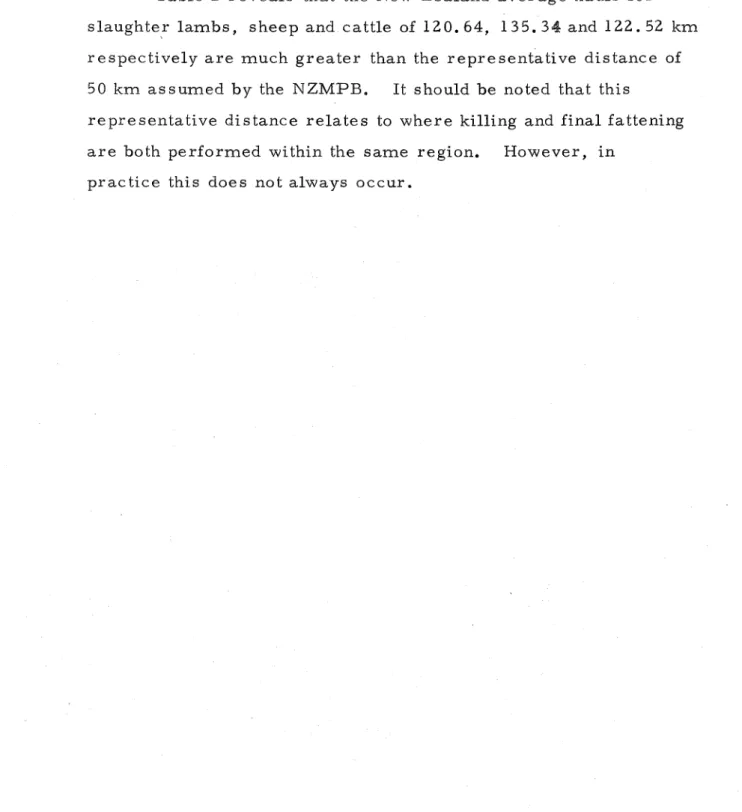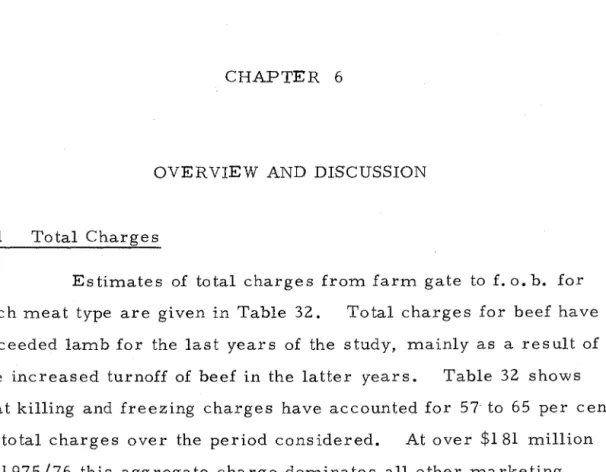The escalation in marketing costs for New Zealand's key exports in recent years is an ongoing concern for producers and the country. Marketing costs for lamb, mutton and beef from the farm up to f. have been identified for each of the six years ending September 30, 1971 through September 30, 1976. Livestock transit through individual processing plants is estimated for each of the six years and has been applied to unit rates to estimate total costs. marketing activities related to different categories of livestock.
7 Lam.b Total Finishes by Works 17. 8 Killing and Freezing Unit Charges for Lam.bs by Works 18 9 Lam.b Average Carcass Weights by Islands for Six Seasons 19 10 Total Killing and Freezing Charges for Export Lam. bs 20. Unit Slaughter and Freezing Charges for Bull Calf 31 19 Total Slaughter and Freezing Charges for Beef Export 33 20 Total Slaughter and Freezing Charges for Export. The second chapter deals with livestock flows and rates for transporting livestock from the farm to the processing works.
CHAPTER 2
Average distances traveled by livestock by region and subregion (km from farm to work, season 1974/75). This creates difficulties in determining the appropriate transport rates for the average distances given in Table 2, as it is for the period under study. These charges were determined by relating the county freight charges on March 31 of each meat selling season to the various distance components in Table 2 and weighting the resulting charges by the various livestock flows within and between regions.
Average distances traveled by livestock by South Island region and sub-region (km farm to works, season 1973/74). Total transport charges have been calculated by using the average inward transport charge per capita for each class of livestock (Table 4) on the total number of each class of export animals slaughtered each season. Appropriate charges per per capita has been adjusted with the factors described in Table 4 to derive transport charges for each season.

CHAPTER 3
Since the throughput of Table 7 was total throughput, the resulting total total charge for each island was adjusted by a factor representing. Unit slaughter and freezing rates for the six seasons considered are presented on a work-per-carcass basis in Table 12. Total slaughter and freezing rates for mutton were first calculated, on a per-work basis, by applying the throughput in Table 11 for the fees of individual works.
Average sheep carcass weights for each season for each island are shown in Table 13. Since the turnover of Table 11 was total turnover, the resulting total total load for each island was adjusted by a factor representing the percentage of that island's total turnover. exported. These factors, together with estimates of total sheep export charges for each island and for New Zealand, are shown in Table 14.
Unit rates for slaughter and freezing for the six seasons considered are presented from the works on a carcass basis in Tables 16, 17 and 18 for the three main export grades of beef (boneless beef, . cooler / GAQ steer and beef bull). Total slaughter and freezing fees for beef animals were calculated by breaking down the total turnover for each island by class. The killing and freezing rates applied to the North Island round were taken from a representative work in the North Island; each class of animal was supposed to have one of three charges; cow, steer or bull.
However, the individual charges for each class varied depending on the average carcass weight for that class. A similar procedure was used to estimate total murder and freezing costs for works in the South Island. Because the throughput in Table 15 was the total throughput, the resulting total charge for each island was adjusted by a factor representing that island's share of the total.
These factors, along with estimates of the total cost of slaughter and freezing for all export beef. Although some information was collected during the preparation of this report on the throughput and cost of killing and freezing calves, information on transportation and. The total cost of killing and freezing beef in the year ending September 30, 1976 was higher than that of sheep and lambs combined, a reversal of the trend since the beginning of the period.
CHAPTER 4
As a result, the NZMPB estimates for transport from the factory to the port in 1974/75 may be understatements of the truth. Although no clarification is available, the geographical notes accompanying the NZMPB estimates indicate that the NZMPB cost calculations relate to the Whakatu or Tomoanaworks (lamb and mutton) and to the Feilding or Longburn works ( in the case of beef). If this is so, the NZMPB's assumed distance for lamb and mutton will be only 20 percent of the national average (as shown in Table 21) and the assumed distance for beef will be only 60 percent of the national average in Table 21 .
It was necessary to use representative NZMPB charges to estimate the total costs for transport from the plant to the port. These representative charges are given for railway, port, port handling and centralization duty; the railroad was separated from this common fee within a few years. It should be noted that the distance analysis provided in Section 4.1 suggests that the NZMPB representative fees may significantly underestimate the actual costs incurred, as the representative fees are based on a 50 km distance from the plant to the port.
£1 if the unit prices shown in Table 22 are applied to the export of different types of meat, the total duty can be estimated. Total cost estimates for lamb, mutton and beef were obtained in this way and are shown in Table 23. Further information on total meat transport costs (all types of meat combined) is given in Table 24; of these aggregates.
Since approximately 87 percent of meat is transported from plants to port by rail, these aggregates were inflated by a factor of 100/87 to obtain the adjusted estimates in Table 24. The total adjusted 11 aggregate may be slightly higher than the 13 percent transported by road. results in lower average charges; this would be because most of the road transport is for short distances in the Southland, Marlborough-Nelson and Auckland regions. The railways with the current estimate of freight charges show that the estimated figures are lower.
This would be expected as the estimated figures are based on an average representative distance which has been shown to be unrealistic due to harbor bypass.
CHAPTER 5
Unit rates for aging and conditioning lamb carcasses are shown in Table 29, together with the number of carcasses and total loads involved. 5.6 Summary of Aggregate Fees for Additional Marketing Activities A summary of aggregate fee estimates for additional marketing activities is provided in Table 31.
CHAPTER 6
However, in 1975/76 export earnings from the sale of by-products amounted to about $74 million; since not all by-products are exported (eg waste derived from blood and bones), the total revenue of the works from killing and freezing operations can be up to 30-40 per cent. The extent to which by-product income affects labor income from year to year is not well documented. While the Ministry of Agriculture and Fisheries considers by-product revenue when reviewing fee increase applications, further analysis of this area would be important in any subsequent investigation into freeze costs and revenue structures.
Although changes in stock levels may affect exports, it is believed that the percentages shown in Table 34 give a fair indication of the proportion of e.g. Indexes for selected unit charges for lamb, mutton and beef for the years under review are shown in Figures 1, 2 and 3. It is clear that for all three types of livestock, slaughter and freezing charges have increased far more than.
Alongside the average marketing charge derived in this report is shown the representative charge for the same type of livestock reported by the NZMPB. Three reasons why the Agricultural Economic Research Unit's rates for lambs are higher than the representative charge are:. i) Aging, conditioning and cutting charges for lambs are included in the average charges. ii) AERU transport charges from farm gate to processing plant are almost double the representative charge. iii). The representative charge is based on a North Island lamb, but South Island slaughter and freezing charges have been 10-20 per cent above North Island charges over the past six years (Table 8).
The NZMPB representative fee is based on a 14.2kg lamb carcass, while the AERU ratings are based on changes in carcass weight from season to season. This difference would increase the representative duty relative to the AERU average. Another contributing factor is the higher cost of killing in the South Island compared to the North Island in previous seasons.
Average beef tariffs are higher than representative tariffs, especially in the latter years of the study period. Different costs associated with transportation from the farm to the processing plant are likely an important causal factor. The fact that the average levy has risen much faster than the representative levy may reflect the changing proportions of the figures.
Both the absolute size of the meat slaughter and freezing bill and the relative increase in slaughter and freezing fees compared to other charges point to the slaughter and. the freezing area as the most important in the meat marketing chain. Important questions to answer include: i) What would be the saving in transport costs if the cattle were transported to the nearest places. ii). To what extent the seasonal production of live animals affects the bypassing of nearby jobs. iii).
How important are plant capacity and utilization to the profitability of freezing operations? iv) Why does a factory processing less than 700,000 sheep and lambs have the same killing and freezing costs as a factory processing just under 2,000 sheep and lambs, ODD? v).
